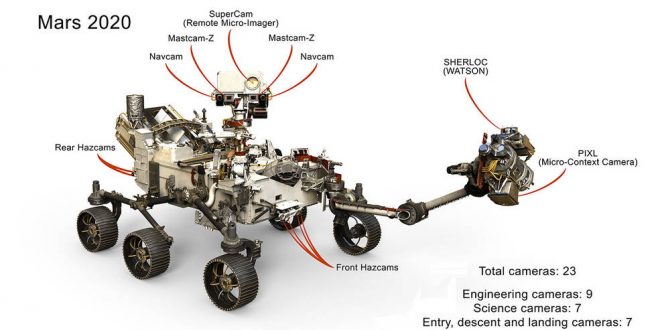NASA’s newest Mars rover will be kitted out with 23 ‘eyes’ to capture more detailed 3D and color images of the Red Planet than ever before.
“Camera technology keeps improving,” says Justin Maki of JPL, Mars 2020’s imaging scientist and deputy principal investigator of the Mastcam-Z instrument, in a press statement. “Each successive mission is able to utilize these improvements, with better performance and lower cost.”
The twenty-three cameras are only the latest chapter in the consistent progress NASA has made on the ocular front. In 1997, when Pathfinder touched down on the Martian surface it came with five cameras. Patherfinder’s rover Sojourner carried three of them. The twin Spirit and Opportunity rovers from 2004 each had ten cameras, and the current Curiosity rover carries seventeen.
The 2020 cameras will serve a wide variety of purposes. There will be an improved version of Curiosity’s MASTCAM, which takes memorable color pictures and color video of the Martian landscape. There will also be engineering cameras capable of getting
“Our previous Navcams would snap multiple pictures and stitch them together,” says Colin McKinney of JPL, product delivery manager for the new engineering cameras. “With the wider field of view, we get the same perspective in one shot.”
But the colors won’t end there: 2020’s SuperCam Remote Micro Imager (RMI) will use “remote optical measurements and laser spectroscopy to determine fine-scale mineralogy, chemistry, and atomic and molecular composition of samples encountered on Mars” in living color, according to the agency’s website. While Curiosity has an imager, it’s in black and white.
There will be six cameras dedicated to capturing entry, landing and descent, which will nab the first video of a parachute opening on another planet. Beyond capturing the event, the 2020 mission will also rely on a camera to guide its landing using Terrain Relative Navigation, where a vehicle’s position is estimated by comparing terrain measurements with a terrain map.
With more cameras come more challenges, specifically trying to get all that data through space. “The limiting factor in most imaging systems is the telecommunications link,” Maki says. “Cameras are capable of acquiring much more data than can be sent back to Earth.”
Compression has become a crucial task for any Mars rover. Advancements in compression on Curiosity have allowed for 3-D imaging, color, and high-speed video. It’s only a few short years before we will see what 2020 can bring.
Agencies/Canadajournal
 Canada Journal – News of the World Articles and videos to bring you the biggest Canadian news stories from across the country every day
Canada Journal – News of the World Articles and videos to bring you the biggest Canadian news stories from across the country every day



